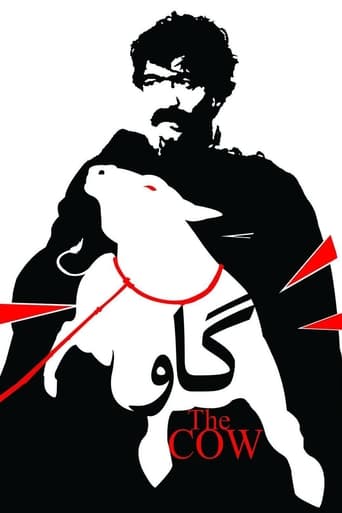morrison-dylan-fan
Nearing the end of ICM's best of 1969 movie poll,I searched for a final title to view. Seeing a post by fellow IMDber OldAle,I was excited to read praise for an Iran New Wave (INW) title, which led to me going down to the farm.View on the film:Farming closer to the Neo- Realist movement than the French New Wave, writer/director Dariush Mehrjui & cinematographer Fereydon Ghovanlou give the village a dour appearance,where the subtle use of black and white shadows lining the streets reflecting what lays at the dark heart of the village. Lovingly following Hassan's feeding of his cow, Mehrju and Ghovanlou take all that Hassan holds dear with flickering camera moves snapping Hassan's breakdown. Dipping into the dark human horror which would be explored the same year in the Czech New Wave film The Cremator, Mehrjui whips Hassan with inhumane treatment from the the locals, captured in frenzied dissolves, fading to the overlooking figures in a landscape.Born from Gholam-Hossein Saedi's play,the screenplay by Mehrjui features the most prominent edge from the Iran New Wave (INW) via Mehrjui dissection of the greed and pettiness followed by all of the rural locals, with the thought they show towards giving Hassan the bad news,burning into vile outbursts as Hassan's mental state degrades. Becoming completely separated from the villagers, Ezzatolah Entezami gives an incredibly expressive performance as Hassan,whose breakdown is treated with a gradual, earthy realism by Entezami,as Hassan looks in hope of seeing the cow on the field.
Magic Lamp
This movie is about as far as one can get from Hollywood blockbusters. Its about a cow. About a cow and a very loving owner. And what happens to them ultimately. There's melancholy and madness in the tragic ending. But the movie also scales new heights in the bonding between human and animals, in this case, a cow. The camera has been used is a surreal way. Shadows and people mix creating a spookiness which adds to the oddity of the general environment depicted. There's very palpable tension in the movie, created by the elements related to the cow and the three shadowy thieves who perhaps symbolize lawlessness. What also struck me was the looming silence of the black burkah-clad women and occasion glimpses of their crinkly faces. All very surreal. There are some very interesting personalities which come alive through the script, other than the cow of course!
Pierre Radulescu
This movie recalls Pasolini in mind, and also Parajanov.The subject is as simple as it can be: there is a village, poor and primitive, Hassan is the only one possessing a cow in the village, the cow dies, Hassan gets mentally insane.Is Hassan mad? Well, obviously. A man who believes that he is no more himself, but his cow, that's madness on all accounts.Madness? Hassan was living in his own universe ignoring the real world. But here's the point: Hassan had always lived in his own universe - he and his cow. A whole system of memories: events lived together. Natural phenomenons lived together and having a particular significance for them: a whole system of codes and signals. Was it full moon? It meant the cow was thirsty.This universe could not disappear once the cow was no more. The memories were still in place. The codes and signals were still in place. Was it full moon? It meant the cow was still thirsty.So Hassan was just defending now this universe of him; only his universe was no more fit with the world. Hence, the madness.Usually, when the beloved one is no more, the survivor is tempted to imagine that the other is still somewhere, not far. You go to the cemetery and speak to your beloved one, who is buried there. Hassan was trying something more forceful: to imagine that he, Hassan was somewhere, not far, and that the cow was here, in his body, instead of him! I know how it sounds, but it was Hassan's way to keep his universe.Meanwhile life was going on in this village. A bunch of clay houses surrounding a small dirty pool. Old men chatting at some kind of a tea house, old women attending silently the daily events and waiting for the outcome, the village idiot tortured by kids for mere distraction, the nightly incursions of neighboring villagers: just a small closed universe around a small dirty pond.Faced with the sudden madness of Hassan, the community comes to help, with great kindness and patience, to discover that help is sometimes useless and that kindness and patience have narrow limits.A tragic ballade telling us that some things happen just because that's their way to happen and nobody could change anything.
davegrenfell
This neglected new wave classic is a fast paced, perfectly edited masterpiece. It rockets along at a thousand miles an hour, and it's impossible to take your eyes off the screen. The shocking opening, of a tormented man having his face smeared with blood by a seemingly military man, sets the stage for an increasingly violent and disturbing movie about one man and his cow, and the hell he descends into.Set in Iran, the basic premise is of two villages, who are constantly stealing each other's cattle, sheep etc. The rival village kills the beloved cow while his owner is away. His friends decide the shock would kill him, and decide to tell him it ran away. However, when he gets back, the shock of its disappearance drives him insane, and he comes to believe that he is in fact the missing cow, even when the villagers tell him the truth. Eventually he is taken into the desert and killed by his former friends, like a cow to the slaughter.You can see why modern Iranian cinema is so slow. It's obviously a reaction against this hyperdelic editing.


